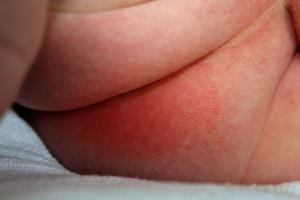Nappy rash
Nappy rash is a rash of the skin in the nappy area, caused by a breakdown of the skin surface in contact with wee or poo for a long time. This causes redness and irritation. It’s best to try to prevent it from happening, rather than have to treat it.
Causes of nappy rash
It is very common. Up to a third of babies and toddlers wearing nappies can have nappy rash at any one time. It doesn't usually develop in newborns, but all babies can get nappy rash.
Nappy rash can be caused by:
- your baby's skin being in contact with wee or poo for a long time
- the nappy rubbing against your baby's skin
- not cleaning the nappy area or changing the nappy often enough
- soap, detergent or bubble bath
- alcohol-based baby wipes
- your baby recently taking antibiotics
There may be red patches on your baby's bottom, or the whole area may be red. Their skin may look sore and feel hot to touch, and there may be spots, pimples or blisters.

Most babies with mild nappy rash don't feel sore.
But if the rash is severe your baby may feel uncomfortable and be distressed.
How to prevent nappy rash
The best way to deal with nappy rash is to try to prevent your baby getting it in the first place.
The simple steps below will help prevent nappy rash as well as help you to clear it up.
How you can treat your baby's nappy rash
If your baby gets nappy rash, you can usually treat their skin yourself:
If the rash isn't upsetting your baby, at each nappy change apply a thin layer of a barrier cream to protect their skin. Ask your health visitor or pharmacist to recommend one.
Follow this advice to help look after your baby's skin.
- change wet or dirty nappies as soon as possible
- clean the whole nappy area gently but thoroughly, wiping from front to back - use water or fragrance-free and alcohol-free baby wipes
- bath your baby daily, but avoid bathing them more than twice a day as that may dry out their skin
- dry your baby gently after washing them – avoid vigorous rubbing
- lie your baby on a towel and leave their nappy off for as long and as often as you can to let fresh air get to their skin
- do not use soap, bubble bath, or lotions
- do not use talcum powder as it contains ingredients that could irritate your baby's skin
Nappy rash usually clears up after about 3 days if you follow these hygiene tips.
If the rash is causing your baby discomfort, your health visitor or pharmacist can recommend a nappy rash cream to treat it.
You should apply the cream first and wait a few minutes before you apply the barrier cream.
Other rashes in the nappy area
If the rash doesn't go away or your baby develops a persistent bright red, moist rash with white or red pimples that spreads into the folds of their skin, they may have an infection.
Ask your pharmacist or health visitor for advice. The pharmacist may recommend a cream for you to use.
If the rash is severe, take your baby to the GP who may prescribe cream or medicine. Follow your GP's instructions on applying barrier cream as well as the prescribed cream.
It's normal for babies to develop skin rashes. But it's important to know the difference between a minor irritation and a condition that requires attention.
Familiarise yourself with everything from nappy rash and eczema to impetigo and meningitis.
More useful links
The information on this page has been adapted from original content from the NHS website.
For further information see terms and conditions.